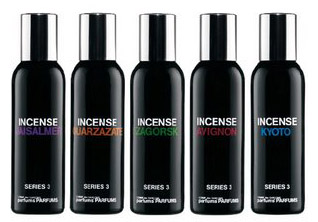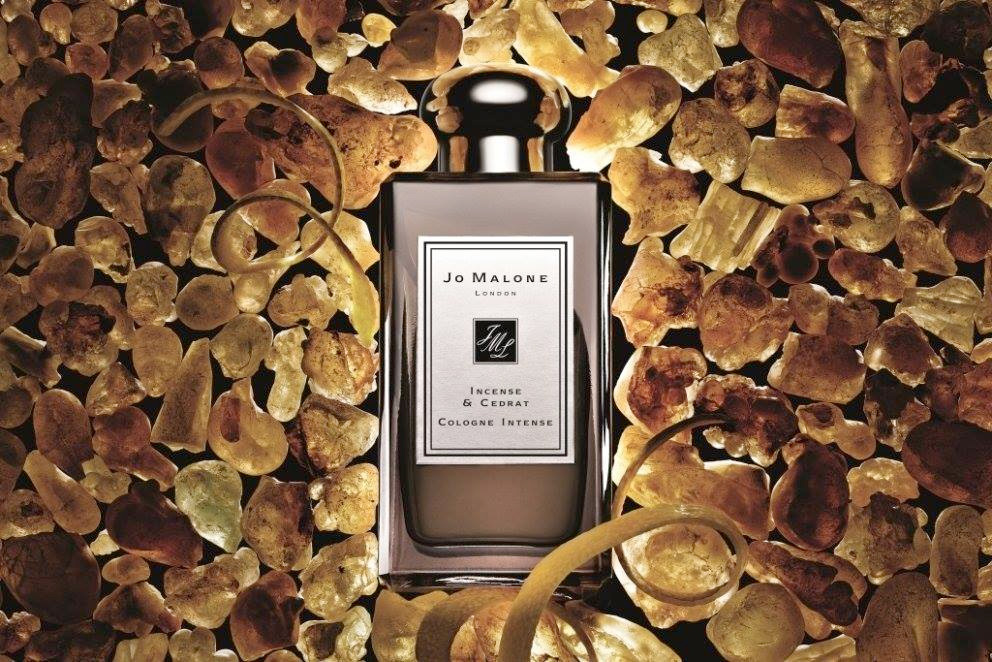[unable to retrieve full-text content] Angel Nova smells like raspberries, ripened to the maximum…

It's Complicated: Incense Citrus
In this series of columns, we undertake subjects and fragrances which pose a certain problem for us. I have recounted in detail my, arguably, tortured relationship with the best-selling (and seminal) Hypnotic Poison by Dior HERE. Other writers find certain notes problematic, such as white musk. Today I'm going to expound on something that bothers me, not because of the smell itself, being as I LOVE incense and citrus by themselves and in any combination, but because of the cultural and psychological connotations they carry.

Let's begin with incense. What is incense, anyway? There are just as many kinds as there are civilizations that have used smoky emanations of fragrant materials to invoke their gods, from the ancient Egyptians and ancient Greeks, all the way to the Hindu temples of the Far East. Per fumum, "through smoke," remains the etymological beginning of our fragrant hobby after all. There are as many permutations of incense that merely labeling something as "incense" almost begs the question: "What kind are you referring to?" Let's not forget that, for some, incense amounts to hippy sticks and Nag Champa–more of a spiritual mood than an organized religion, per se.
Personally, I've known about my love since childhood. Maybe some smells are ingrained into our "likes" from very early on from the smells surrounding our mothers and consumed during child-bearing. I wish I had asked my mother what it was. Frankincense/Olibanum and myrrh are two of my favorite scents in the whole world, but when I choose to wear them as my personal fragrance, they invariably bring on this comment from other people: "You smell like church."
The fragrances vary, from the summer-clean Passage d'Enfer (L'Artisan Parfumeur), to La Myrrhe (Serge Lutens), to Messe de Minuit (Etro), and all the way to Avignon (Comme des Garcons). Other favorites include L'Eau Trois (Diptyque), which I included as my personal entry in our Best in Show: Incense/Olibanum; Armani's Bois d'Encens; Guerlain's Encens Mythique with its inclusion of aloeswood, another incense material; and the cult, discontinued marvels Norma Kamali Incense and Mathew Williamson Incense (the original scent).

Now there's nothing inherently bad about this. Especially in my own culture, where people do not view church-going as compulsory and there is no moral stigma in saying incense is not to their liking, smelling like a church, an altar boy, or an orthodox priest should therefore, theoretically at least, be a neutral statement. A statement of fact.
However–and this is a big however–there is an undercurrent of something more sinister in anyone's assessment of scent. We tend to connote meaning onto scent that we do not freely transfer onto image or sound because we stop and consider with those stimuli. We self-censor. Smell, on the other hand, freely enters our being with each breath we take; it's unstoppable. Because our civilization lacks the vocabulary to accurately articulate our feelings regarding smell, we tend to have visceral reactions, reactions that rely mostly on biological wirings (an aversion to bitter taste because it might indicate spoiled food or poison), and on long-developed associations with specific things and places.
Comme des Garcons was among the first to explore the idea that people have cultural associations with burned materials. ("Incense," after all, comes from the Latin verb meaning "to burn.") They launched not one but five scents in their iconic Incense Series, each geographically codified to appeal to a specific sensibility and religious context.

In the case of frankincense, which happens to be the main material of ecclesiastical incense–the kind that is burned in censers in Christian Orthodox and Catholic churches, the assocation with church is a given, even for the non-pious. The emanations from the church escape into the air, and the congregation has fumigated their clothes during service just enough, so that a subtle trail can be caught by a sensitive nose outside afterwards.
Judging by the comments received, I tend to interpret the dissatisfaction as an objection to said segregation. The church is populated by the old in our corner of the world, and the mingled emanations of their chosen perfumes and colognes with the frankincense in the censer is a mix that can be heavenly to some (since most older ladies tend to stick with their powdery, green chypres and spicy orientals that were en vogue when I was a kid), and hellish to others (generations brought up on ever-sweeter gourmands are challenged by it, and that's understandable, too). Women wearing Magie Noire to church are the universe's irony, it seems. Scent does have a tendency to stick to clothes and on hair, so in a close space, the effect is potent. Many women over the years have worn Opium (YSL) in church, so much so that I have specifically noticed several local brands of ecclesiastical goods being inspired to scent their incense and sacred oils similarly to the stated Yves Saint Laurent fragrance!
Now Opium is, indeed, heavily relying on myrrh and frankincense shades, with lots of clove, which also brings to mind medicinal associations that are not tied to comfort and nurturing. The mingling with the surrounding frankincense only serves to reinforce that association. Oddly enough, Opium is my one incense-heavy scent that people tend to not associate with incense when I wear it; the most common comment I get is that it's wonderful, and that it smells like flowers. (One has to wonder what the hell, pardon the pun, is happening, but that's fodder for another tale, another day!)

This critical analysis has resulted in a sort of revelation to me. People often object to scents that remind them of old age (a fact that I have analyzed already in my article about "Negative Comments on Your Favorite Perfume" HERE), and an underlying ageism is hiding behind that fact. The overwhelming response of people regarding scent is that they want something warm and something either comforting or deep, intended for a more charged mood. Incense fragrances tend to be unsettling for them, unless they have similar tastes like myself, especially when the scent leans into the cold and medicinal. La Liturgie des Heures by Jovoy is a great example of that. Even incense-loving people have difficulty with this one, as it reminds them of a crypt. It's much easier to like something like Kyoto (Comme des Garcons), and Cardinal (Heeley) is between the two with its smokiness.
Many incense fragrances appear detached and unsexy (taking into account a median assessment of sexiness), whereas many women and men use perfume as a way to attach rather than detach, to create contact rather than apostasy. In a way, incense lies at that precarious threshold between the devil and the deep sea: Is it a medium to reach the gods, or a reminder of the distance that lies between mortal man and God?
You tell me!
Where does citrus enter the equation after all, you might ask. Let me explain.

Citruses are also sort of frowned upon, especially in my culture, as a fine fragrance for younger and middle-aged people. They also get an association with the old, or with cheap colognes used in a pinch for cleaning/disinfecting. The Turkish have a similar habit of washing down everything (countertops to tables) with Limon Kolonyasi, i.e. lemon-scented cologne, which makes for a perceived cheapening of the experience. It's a case of a European simile to Pledge, if you will. In the US, someone in the 1960's decided that lemon was the scent of clean, and it stuck. On my side of the world, citrus is abundant, and it enters almost every dish, and lemon cologne (including the classic 4711 Eau de Cologne) is what is splashed on when one is ill, a small child, or elderly. It's ageism again, this time huddled in the impediment of innocence attached to childhood. Citruses cannot be seen as sexy in this context, though it could be argued that they can be comforting.

However, it is citrus's, and specifically lemon's, tie with incense which compelled me to rethink the whole thing and view it in a new light. Frankincense, you see, has a lemony/citrusy facet in its olfactory profile (same as vetiver), which makes it somewhat acrid when burned, especially as a top note. When it's emphasized in a composition, the end result is, indeed, rather cold. You can study the way hesperidic notes bring out the lemony facets of frankincense in Incense and Cedrat by Jo Malone.
Furthermore, a very popular, cheap cologne scented with lemon, Mirto Lemon, is used by endless altar boys and ladies who frequent the church for cleaning up and disinfecting the glass panes on the icons. Upon entering an Orthodox church, it is customary to deposit a very fleeting kiss on the icons in the entrance while making the sign of the cross, a reminder of our own mortality and the pious belief in resurrection and eternal life.

Lo and behold, citrus and incense have gained a reputation that's well beyond their capacities: The proximity to the grave. No wonder it's complicated.
Read the author's collected articles on this LINK.
 |
Elena Vosnaki Elena Vosnaki is a historian & perfume writer from Greece and a Writer for Fragrantica. She is the founder & editor of Perfume Shrine, one of the most respected independent online publications on perfume. Her writing was recognized at the Fifi Awards for Editorial Excellence in 2009 and in 2011. She is consulted as a fragrance historian & expert, and has been curating fragrance installations at museum exhibits at the Milan Expo 2015 and elsewhere. She also contributes to publications around the world. |



